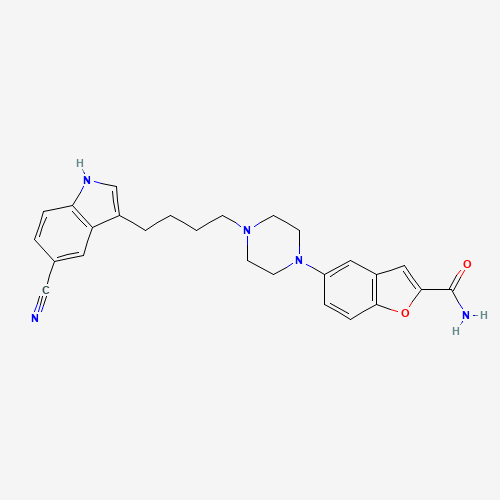| Pharmaceutical Information |
| Drug Name |
Vilazodone |
| Drug ID |
BADD_D02456 |
| Description |
Vilazodone is a novel compound with combined high affinity and selectivity for the 5-hydroxytryptamine (5-HT) transporter and 5-HT(1A) receptors[Label,A177622]. Vilazodone may also be associated with less sexual dysfunction and weight gain[A6947]. Vilazodone was given FDA approval on January 21, 2011[L6046,A177622]. |
| Indications and Usage |
Vilazodone is approved for treatment of major depressive disorder.[Label,A38477,A177622] |
| Marketing Status |
approved |
| ATC Code |
N06AX24 |
| DrugBank ID |
DB06684
|
| KEGG ID |
D09698
|
| MeSH ID |
D000069503
|
| PubChem ID |
6918314
|
| TTD Drug ID |
D0X6BV
|
| NDC Product Code |
Not Available |
| UNII |
S239O2OOV3
|
| Synonyms |
Vilazodone Hydrochloride | Hydrochloride, Vilazodone | 2-benzofurancarboxamide, 5-(4-(4-(5-cyano-1H-indol-3-yl)butyl)-1-piperazinyl)-, hydrochloride (1:1) | Vilazodone HCl | HCl, Vilazodone | Viibryd | EMD 68843 | 68843, EMD | EMB-68843 | EMB 68843 | EMB68843 | Vilazodone | 5-(4-(4-(5-cyano-3-indolyl)butyl)-1-piperazinyl)benzofuran-2-carboxamide |
|
| Chemical Information |
| Molecular Formula |
C26H27N5O2 |
| CAS Registry Number |
163521-12-8 |
| SMILES |
C1CN(CCN1CCCCC2=CNC3=C2C=C(C=C3)C#N)C4=CC5=C(C=C4)OC(=C5)C(=O)N |
| Chemical Structure |

|
|
| ADRs Induced by Drug |
|
|
*The priority for ADR severity classification is based on FAERS assessment, followed by the most severe level in CTCAE rating. If neither is available, it will be displayed as 'Not available'.
**The 'Not Available' level is hidden by default and can be restored by clicking on the legend twice..
|
|
|

